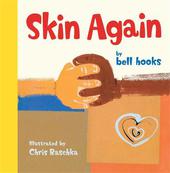
|
Skin Again
Hardback
Main Details
| Title |
Skin Again
|
| Authors and Contributors |
By (author) Bell Hooks
|
|
Illustrated by Chris Raschka
|
| Physical Properties |
| Format:Hardback | | Pages:40 | | Dimensions(mm): Height 244,Width 208 |
|
| ISBN/Barcode |
9781484799239
|
| Audience | |
|---|
|
Publishing Details |
| Publisher |
Hyperion
|
| Imprint |
Hyperion
|
| Publication Date |
6 June 2017 |
| Publication Country |
United States
|
Description
The skin I'm in is just a covering. It cannot tell my story. The skin I'm in is just a covering. If you want to know who I am, you have got to come inside and open your heart way wide. Celebrating all that makes us unique and different, Skin Again offers new ways to talk about race and identity. Race matters, but only so much--what's most important is who we are on the inside. Looking beyond skin, going straight to the heart, we find in each other the treasures stored down deep. Learning to cherish those treasures, to be all we imagine ourselves to be, makes us free. This award-winning book, with its myriad of faces, introduces a strong message of loving yourself and others that will appeal to parents of our youngest readers.
Author Biography
A world-renowned cultural critic, feminist theorist, and intellectual, bell hooks is a distinguished author and professor of English. She has written several acclaimed children's books including Be Boy Buzz, Skin Again and Happy to Be Nappy, all illustrated by Chris Raschka. Chris Raschka is the Caldecott-Award-winning illustrator of The Hello Goodbye Window and A Ball for Daisy. He also received a Caldecott Honor for Yo! Yes? and has written and illustrated numerous books for children, among them four by bell hooks. He lives with his wife and son in New York City.
ReviewsIn Raschka's exuberant paintings, an unpeeled-onion motif implies the multiplicity of stories beneath a person's visible surface, and dancing children, with varied hues of skin and reckless swirls of hair, suggest common interest and love. With torn paper rectangles, Raschka establishes quilty grids on the pages, and limits his characters in wide brushstrokes within these boxy spaces. Jazzy dashes and daubs of earth-tone paint suggest African batik or Aboriginal art.--Publishers Weekly Raschka does his usual extraordinary job of illustrating highly abstract concepts: children of different colors -- rendered in smudgy paints -- look at, point at, and reach out to each other, finally clasping hands in a sort of a graphic minuet.--Kirkus Reviews
|